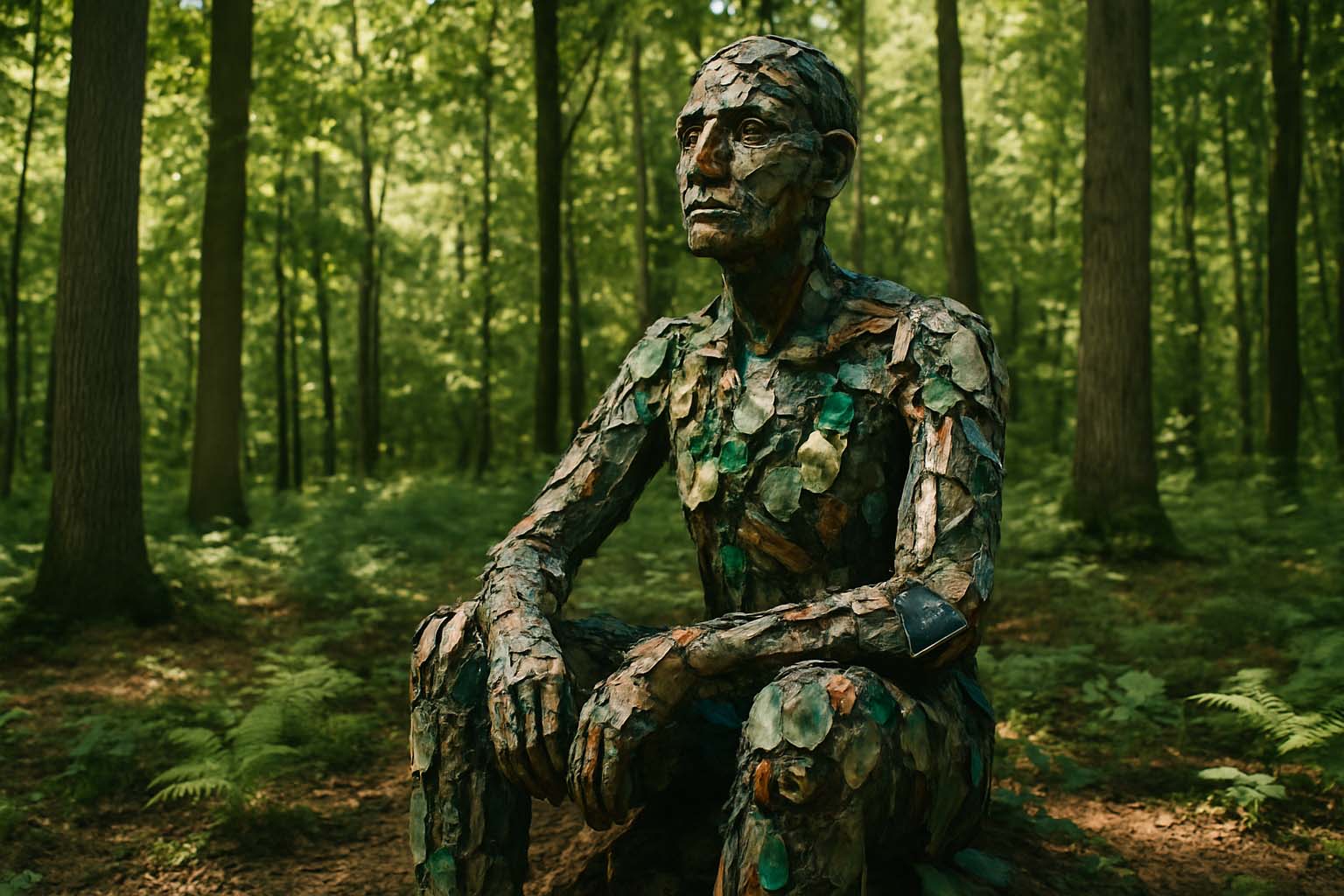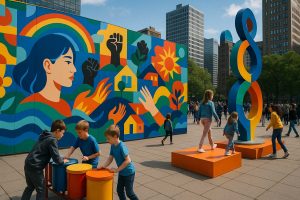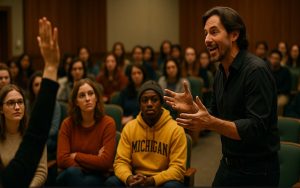
Artists from Wisconsin Championing Environmental Themes
Setting the Stage
Art mirrors society, reflecting goals and pressing issues. Environmental concerns hold central importance now. From Europe’s bustling cities to quiet American towns, art sparks awareness and reconnection with nature. In Wisconsin, known for its lakes, forests, and thriving artist communities in creative spaces, local creators aim not only to produce beautiful pieces but also to deepen public understanding of the planet’s fragile state. The state’s forests have long inspired creative work, from early landscape painters to modern activists, shaping how artists address environmental topics today.
Using Art to Highlight Environmental Challenges
Climate change, deforestation, and ocean pollution demand attention. Wisconsin artists address these issues directly. Painter Mary Lingen creates landscapes marked by symbols of climate impact. Her work reminds viewers of what stands to vanish if people remain inactive.
Other creators use recycled materials, organic pigments, and repurposed waste to produce art with minimal carbon impact. One collective transforms plastic bottles into stained-glass-like pieces that catch sunlight in community centers. Another group rescues wood and metal from abandoned barns to build outdoor sculptures in public parks. By involving community members in material collection, artists foster a direct connection between observers and sustainable practices.
Emotional and Cultural Resonance
Art’s strength lies in stirring emotions. A painting of a flooded forest or a river clogged with debris evokes fear or sorrow more effectively than charts and numbers. Such feelings can translate into action, inspiring viewers to join environmental groups or adopt sustainable habits. After viewing a powerful mural depicting a melting glacier, one community member organized a neighborhood discussion on reducing plastic waste.
Wisconsin’s impact spreads beyond state borders. Galleries in Madison and Milwaukee curate traveling exhibitions that reach cities nationwide. Some institutions use virtual reality to immerse audiences in melting glaciers or polluted waterways. Wearing VR headsets, people experience simulated Arctic expeditions or dive beneath toxic rivers. This sensory experience delivers urgency without requiring people to visit these remote sites.
Schools collaborate with galleries to schedule field trips. Students engage with installations showing wildlife soundscapes and scientific narration, making lessons on ecology and ethics more impactful.
Bridging Art and Science Worldwide
Wisconsin artists participate in global collaborations with scientists. Known as “SciArt,” these projects unite creative expression and scientific research. Visual artists partner with climatologists, ecologists, and oceanographers to ensure accuracy.
For example, an artist might visualize decades of temperature data as shifting color gradients on canvas. As blues transition to reds, viewers grasp rising temperatures through visual storytelling. Other works integrate soil samples or fungal networks into sculptures, referencing ecological studies. Some pieces appear in scientific journals next to research articles, emphasizing their dual role as art and data visualization.
Local universities host events where artists present alongside science professors. These forums help non-experts engage with environmental data and artistic techniques alike. Botanical gardens pair sculptures with native plant displays, illustrating ecosystem responses to climate shifts. Visitors see art and real-life examples of adaptation side by side.
Local Perspective Fueling Global Movements
Though Wisconsin lies in the American Midwest, its artists maintain strong international connections. Exhibits in Berlin, Tokyo, and Copenhagen feature Wisconsin art focused on environmental themes. Curators select these works for exhibitions on sustainable creativity and climate action awareness.
Locally, programs like “Art in the Park” in Madison and Milwaukee blend live painting, workshops, and clean-up drives. During summer weekends, residents watch artists create works from found objects while volunteers collect trash. Puzzle hunts teach children about invasive species and endangered plants. These events inspire other cities in Canada and Scandinavia to adopt similar models through artist exchange programs.
An Illustration of Impact from a Local Exhibit
At Racine Art Museum, Hannah Kreuger’s installation drew wide attention. She collected plastic debris from rivers and streams to craft a life-size fish sculpture coated in oil-like resin. Initially, the piece appears colorful and captivating. On closer inspection, layers of grime and peeling surfaces reveal pollution’s stark reality.
A visitor recalled, “After seeing that sculpture, I never view plastic bottles the same way. Their convenience felt trivial when I grasped their harm.” Following the exhibit, local schools integrated environmental art into their curricula. Students created sculptures from recycled materials, learning artistic techniques and pollution science.
Nurturing Future Environmental Artists
Wisconsin’s commitment to environmental art continues through education and mentorship. Workshops introduce youth to nature’s value via creative processes. Projects like painting with natural dyes or crafting collages from recycled paper teach sustainable approaches. Participants learn to identify local plants for dye-making, understand composting, and appreciate natural resources.
High school programs connect students with professional artists. Summer residencies near wetlands or forests provide stipends, materials, and exhibition space. Students present final works at year-end showcases, receiving feedback from community members and environmental experts.
At the collegiate level, art degrees now include sustainability modules. Courses cover life cycle analysis of artworks, ethical material sourcing, and the carbon footprint of exhibitions. Students learn to plan eco-friendly events and choose low-impact packaging for shipments.
Support from Art Organizations and Galleries
Institutional backing is key for environmental art in Wisconsin. Groups like Wisconsin Visual Artists and Milwaukee Institute of Art & Design offer grants, exhibition space, and networking. These resources validate advocacy-driven art that may not align with traditional gallery norms.
Municipal art councils allocate funds for public projects promoting environmental awareness. In partnership with local governments, they install energy-efficient lighting and solar panels at outdoor exhibit sites. This infrastructure ensures environmental art remains visible without adding to ecological strain.
Festivals like Madison’s Green Arts Fair bring together artists, environmental groups, and community leaders. Attendees explore booths featuring eco-friendly materials, purchase sustainable art, and attend workshops on upcycling and green architecture. These events help align artistic vision with environmental priorities.
Facing Challenges and Celebrating Achievements
While environmental art gains momentum, practitioners face challenges. Securing consistent funding can be difficult when art markets favor traditional genres. Artists often balance commercial commissions with advocacy-driven work. Despite these hurdles, many achieve notable successes. Some projects result in policy discussions at city council meetings. Fundraising auctions for eco-art projects have raised thousands of dollars to support local conservation efforts.
Community feedback often highlights art’s role in shifting public opinion. Local surveys reveal increased support for protective measures after environmental exhibits. Awards from art institutions and environmental groups recognize artists’ contributions, further validating their efforts.
Art Integrated into Everyday Life
Environmental themes appear far beyond galleries. Murals on public walls, school posters, and social media campaigns reach daily audiences. In Milwaukee, artists paint murals of native wildlife on public buildings to raise awareness of local ecosystems. In rural community centers, rotating exhibits feature regional environmental concerns and tell stories of local conservation efforts.
Digital platforms play a vital role. Wisconsin artists share time-lapse videos of eco-friendly projects, tutorials on making natural dyes, and studio insights online. Followers engage by sharing ideas, commenting, and collaborating on virtual art challenges. Online communities support environmental artists by exchanging knowledge and resources.
Tattoo artists also participate, using vegan ink and crafting nature-themed designs. Some partner with conservation groups to sell limited-run pieces, donating proceeds to habitat restoration. These efforts show how art blends with fashion, education, and social advocacy, connecting with diverse audiences in unexpected ways.
Valuing Art with Purpose
Climate change and habitat loss remain urgent. A committed wave of artists refuses to relent. Their creations depict a world worthy of protection—one where nature thrives, and communities collaborate for sustainable living.
Each brush stroke, sculpture, and performance carries a call to action. Though these voices may not dominate mainstream media, they persist. Collectively, their work cultivates empathy and strengthens grassroots movements. Through public events and online campaigns, they urge policymakers and citizens alike to prioritize environmental resilience.
Moving Forward
Wisconsin’s environmental artists serve as guardians of nature’s story. Blending creativity with advocacy, they offer warnings and hope. Their work invites individuals to reflect on daily choices and fosters a culture where art and sustainability intersect. As their message spreads, stronger bonds form between communities and the natural world. Their journey affirms a vital truth: people united through art can safeguard our planet’s future.

